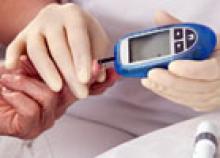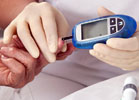User login
Glycemic control in hospitalized patients is possible without having to achieve the much-debated standard of intensive glycemic control. That’s what Irl Hirsch, MD, professor of medicine at the University of Washington in Seattle, said in a presentation on management of diabetes in the hospitalized patient at the UCSF conference.
“We instituted intravenous insulin protocols throughout our hospital in 1992,” before recent medical controversies about IGC, Dr. Hirsch said. Eventually, a target weight dimension of 100 to 180 mg/dL of blood glucose became the hospital standard.
The number of hospitalized patients with diabetes increased 93% between 1988 and 2009. Many hospitalists encounter diabetics and order insulin for them every day, Dr. Hirsch said. Although hyperglycemia, which is seen in 78% of hospitalized patients with diabetes and 26% of those without, is linked to mortality regardless of diabetic status, mortality is greater in patients with diabetes, especially in those newly diagnosed with hyperglycemia, Dr. Hirsch said.1 Hypoglycemia often is overlooked due to
Doctors need to find a safe middle ground, he said, noting that intensive insulin therapy has not been shown to improve major outcomes, including ICU mortality. “The real danger is that we can’t get glucose under tight control without risking hypoglycemia,” he said. “We’ve had almost no hypoglycemia in our hospital for the past couple of years.”
In his talk, Dr. Hirsch took particular issue with the persistence of “sliding scale” approaches to titrating insulin therapy in hospitalized patients, basing the amount of insulin on current glucose level but not taking into consideration how long previous insulin treatments might be active or whether the insulin is “stacking” in the patient’s bloodstream. “The sliding scale doesn’t work. It’s dangerous, and that’s why I’m on this crusade,” he stated. Over time, basal bolus administration works better, Dr. Hirsch said, adding that continued improvements in the technology of continuous glucose monitoring will help to put an end to the controversy. TH
Larry Beresford is a freelance writer in San Franscisco.
Reference
1. Kosiborod M, Inzucchi S, Clark B, et al. National patterns of glucose control among patients hospitalized with acute myocardial infarction. J Am Coll Cardiol. 2007;49:1018–1183:1283A.
Glycemic control in hospitalized patients is possible without having to achieve the much-debated standard of intensive glycemic control. That’s what Irl Hirsch, MD, professor of medicine at the University of Washington in Seattle, said in a presentation on management of diabetes in the hospitalized patient at the UCSF conference.
“We instituted intravenous insulin protocols throughout our hospital in 1992,” before recent medical controversies about IGC, Dr. Hirsch said. Eventually, a target weight dimension of 100 to 180 mg/dL of blood glucose became the hospital standard.
The number of hospitalized patients with diabetes increased 93% between 1988 and 2009. Many hospitalists encounter diabetics and order insulin for them every day, Dr. Hirsch said. Although hyperglycemia, which is seen in 78% of hospitalized patients with diabetes and 26% of those without, is linked to mortality regardless of diabetic status, mortality is greater in patients with diabetes, especially in those newly diagnosed with hyperglycemia, Dr. Hirsch said.1 Hypoglycemia often is overlooked due to
Doctors need to find a safe middle ground, he said, noting that intensive insulin therapy has not been shown to improve major outcomes, including ICU mortality. “The real danger is that we can’t get glucose under tight control without risking hypoglycemia,” he said. “We’ve had almost no hypoglycemia in our hospital for the past couple of years.”
In his talk, Dr. Hirsch took particular issue with the persistence of “sliding scale” approaches to titrating insulin therapy in hospitalized patients, basing the amount of insulin on current glucose level but not taking into consideration how long previous insulin treatments might be active or whether the insulin is “stacking” in the patient’s bloodstream. “The sliding scale doesn’t work. It’s dangerous, and that’s why I’m on this crusade,” he stated. Over time, basal bolus administration works better, Dr. Hirsch said, adding that continued improvements in the technology of continuous glucose monitoring will help to put an end to the controversy. TH
Larry Beresford is a freelance writer in San Franscisco.
Reference
1. Kosiborod M, Inzucchi S, Clark B, et al. National patterns of glucose control among patients hospitalized with acute myocardial infarction. J Am Coll Cardiol. 2007;49:1018–1183:1283A.
Glycemic control in hospitalized patients is possible without having to achieve the much-debated standard of intensive glycemic control. That’s what Irl Hirsch, MD, professor of medicine at the University of Washington in Seattle, said in a presentation on management of diabetes in the hospitalized patient at the UCSF conference.
“We instituted intravenous insulin protocols throughout our hospital in 1992,” before recent medical controversies about IGC, Dr. Hirsch said. Eventually, a target weight dimension of 100 to 180 mg/dL of blood glucose became the hospital standard.
The number of hospitalized patients with diabetes increased 93% between 1988 and 2009. Many hospitalists encounter diabetics and order insulin for them every day, Dr. Hirsch said. Although hyperglycemia, which is seen in 78% of hospitalized patients with diabetes and 26% of those without, is linked to mortality regardless of diabetic status, mortality is greater in patients with diabetes, especially in those newly diagnosed with hyperglycemia, Dr. Hirsch said.1 Hypoglycemia often is overlooked due to
Doctors need to find a safe middle ground, he said, noting that intensive insulin therapy has not been shown to improve major outcomes, including ICU mortality. “The real danger is that we can’t get glucose under tight control without risking hypoglycemia,” he said. “We’ve had almost no hypoglycemia in our hospital for the past couple of years.”
In his talk, Dr. Hirsch took particular issue with the persistence of “sliding scale” approaches to titrating insulin therapy in hospitalized patients, basing the amount of insulin on current glucose level but not taking into consideration how long previous insulin treatments might be active or whether the insulin is “stacking” in the patient’s bloodstream. “The sliding scale doesn’t work. It’s dangerous, and that’s why I’m on this crusade,” he stated. Over time, basal bolus administration works better, Dr. Hirsch said, adding that continued improvements in the technology of continuous glucose monitoring will help to put an end to the controversy. TH
Larry Beresford is a freelance writer in San Franscisco.
Reference
1. Kosiborod M, Inzucchi S, Clark B, et al. National patterns of glucose control among patients hospitalized with acute myocardial infarction. J Am Coll Cardiol. 2007;49:1018–1183:1283A.

